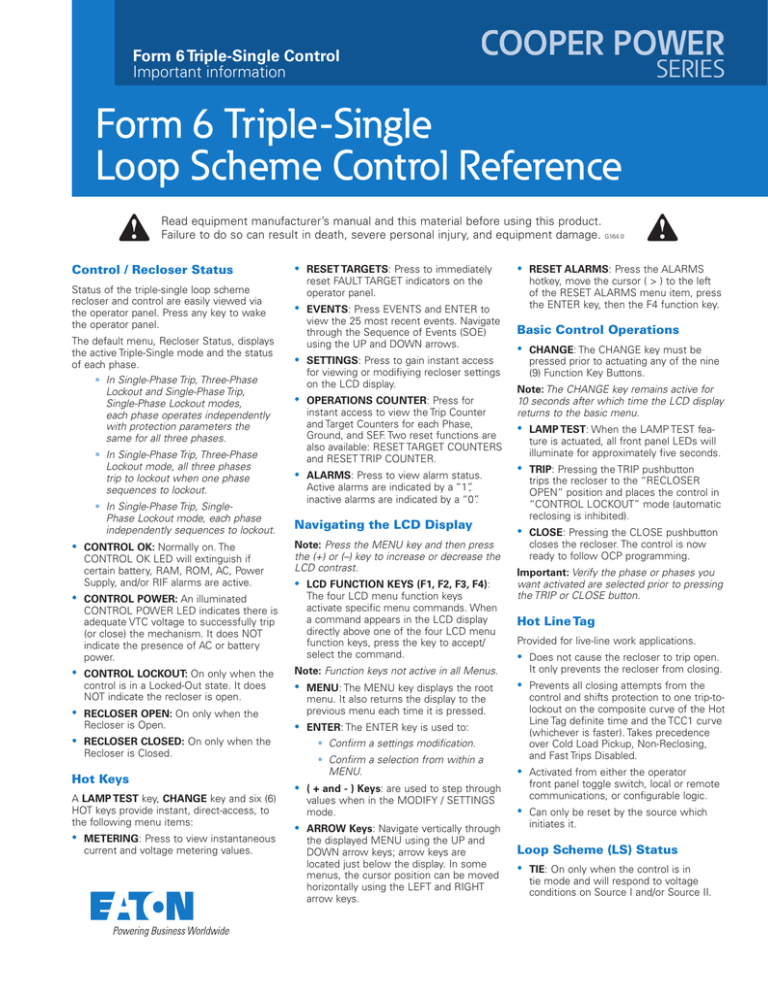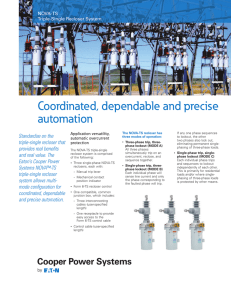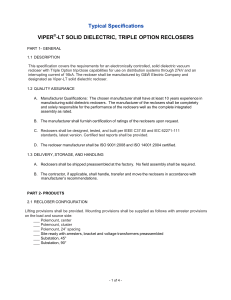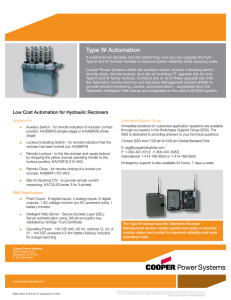
FNrm 6 Triplt-Singlt CNnorNl
Important information
COOPER POWER
SERIES
Form 6 Triple-Single
Loop Scheme Control Reference
Read equipment manufacturer’s manual and this material before using this product.
Failure to do so can result in death, severe personal injury, and equipment damage. G164.0
Control / Recloser Status
Status of the triple-single loop scheme
recloser and control are easily viewed via
the operator panel. Press any key to wake
the operator panel.
The default menu, Recloser Status, displays
the active Triple-Single mode and the status
of each phase.
• In Single-Phase Trip, Three-Phase
Lockout and Single-Phase Trip,
Single-Phase Lockout modes,
each phase operates independently
with protection parameters the
same for all three phases.
• In Single-Phase Trip, Three-Phase
Lockout mode, all three phases
trip to lockout when one phase
sequences to lockout.
• In Single-Phase Trip, SinglePhase Lockout mode, each phase
independently sequences to lockout.
• CONTROL OKe Normally on. The
CONTROL OK LED will extinguish if
certain battery, RAM, ROM, AC, Power
Supply, and/or RIF alarms are active.
• CONTROL POWERe An illuminated
CONTROL POWER LED indicates there is
adequate VTC voltage to successfully trip
(or close) the mechanism. It does NOT
indicate the presence of AC or battery
power.
• CONTROL LOCKOUTe On only when the
control is in a Locked-Out state. It does
NOT indicate the recloser is open.
• RECLOSER OPENe On only when the
Recloser is Open.
• RECLOSER CLOSEDe On only when the
Recloser is Closed.
Hot Keys
A LAMP TEST key, CHANGE key and six (6)
HOT keys provide instant, direct-access, to
the following menu items:
• METERING: Press to view instantaneous
current and voltage metering values.
• RESET TARGETS: Press to immediately
reset FAULT TARGET indicators on the
operator panel.
• EVENTS: Press EVENTS and ENTER to
view the 25 most recent events. Navigate
through the Sequence of Events (SOE)
using the UP and DOWN arrows.
• SETTINGS: Press to gain instant access
for viewing or modifiying recloser settings
on the LCD display.
• OPERATIONS COUNTER: Press for
instant access to view the Trip Counter
and Target Counters for each Phase,
Ground, and SEF. Two reset functions are
also available: RESET TARGET COUNTERS
and RESET TRIP COUNTER.
• ALARMS: Press to view alarm status.
Active alarms are indicated by a “1”,
inactive alarms are indicated by a “0”.
Navigating the LCD Display
NNote Press the MENU key and then press
the (+) or (–) key to increase or decrease the
LCD contrast.
• LCD FUNCTION KEYS (F1, F2, F3, F4):
The four LCD menu function keys
activate specific menu commands. When
a command appears in the LCD display
directly above one of the four LCD menu
function keys, press the key to accept/
select the command.
NNote Function keys not active in all Menus.
• MENU: The MENU key displays the root
menu. It also returns the display to the
previous menu each time it is pressed.
• ENTER: The ENTER key is used to:
• Confirm a settings modification.
• Confirm a selection from within a
MENU.
• ( + and - ) Ktye: are used to step through
values when in the MODIFY / SETTINGS
mode.
• ARROW Ktye: Navigate vertically through
the displayed MENU using the UP and
DOWN arrow keys; arrow keys are
located just below the display. In some
menus, the cursor position can be moved
horizontally using the LEFT and RIGHT
arrow keys.
• RESET ALARMS: Press the ALARMS
hotkey, move the cursor ( > ) to the left
of the RESET ALARMS menu item, press
the ENTER key, then the F4 function key.
Basic Control Operations
• CHANGE: The CHANGE key must be
pressed prior to actuating any of the nine
(9) Function Key Buttons.
NNote The CHANGE key remains active for
10 seconds after which time the LCD display
returns to the basic menu.
• LAMP TEST: When the LAMP TEST feature is actuated, all front panel LEDs will
illuminate for approximately five seconds.
• TRIP: Pressing the TRIP pushbutton
trips the recloser to the “RECLOSER
OPEN” position and places the control in
“CONTROL LOCKOUT” mode (automatic
reclosing is inhibited).
• CLOSE: Pressing the CLOSE pushbutton
closes the recloser. The control is now
ready to follow OCP programming.
ImpNroanoe Verify the phase or phases you
want activated are selected prior to pressing
the TRIP or CLOSE button.
Hot Line Tag
Provided for live-line work applications.
• Does not cause the recloser to trip open.
It only prevents the recloser from closing.
• Prevents all closing attempts from the
control and shifts protection to one trip-tolockout on the composite curve of the Hot
Line Tag definite time and the TCC1 curve
(whichever is faster). Takes precedence
over Cold Load Pickup, Non-Reclosing,
and Fast Trips Disabled.
• Activated from either the operator
front panel toggle switch, local or remote
communications, or configurable logic.
• Can only be reset by the source which
initiates it.
Loop Scheme (LS) Status
• TIE: On only when the control is in
tie mode and will respond to voltage
conditions on Source I and/or Source II.
• SECTIONALIZER: On only when the
control is in sectionalizing mode and will
respond to voltage conditions on Source I.
NNote When in Sectionalizing mode, the
SOURCE II ENABLED function key is not
responding to voltage even though it is
illuminated.
• LS DISABLED: On only when LS is
disabled and the control will not respond
to the programmed LS loss of voltage
parameters.
NNotes In the event of loss of AC control
power to the control (without battery backup power), the LS functionality will be
disabled when power is restored to the
control.
In TIE or SECTIONALIZING mode, once
voltage is restored, the LS is disabled until
locally or remotely enabled.
LS functionality must be enabled via the
ProView interface software.
• A, B, and C PHASE VOLTAGE: When on,
these LEDs indicate the phase(s) that initiated the LS action.
Default Function Key Buttons
Also, refer to “CHANGE” key description.
• GND TRIP BLOCKED: Blocks all ground
sensing in the control for the active profile.
• NON-RECLOSING: Places the control
in 1-Shot-to-Lockout mode. When activated, the control will follow the next
programmed TCC and a “Control Lockout”
will follow the OCP trip event.
• SUPERVISORY OFF: When activated,
supervisory commands via Contact I/O or
any of the communications accessories
are ignored.
• PHASE SELECT BUTTONS: Pressing
the Change button followed by a press
of the A or B or C Phase Select button
activates the respective phase; repeating
the button press sequence a second time
deactivates the phase. The control panel
Trip and Close pushbuttons will operate
any active phase(s).
• 1-Phase Trip / 3-Phase Lockout, mode
• 3-Phase Trip / 3-Phase Lockout
(ganged) mode
• X, Y, Z PHASE VOLTAGE: When on, these
LEDs indicate Source II (load) voltage is
present on X, Y, or Z phase(s).
• If LS is enabled, at the moment loss
of voltage occurs, the LEDs for the
phases that lost voltage turn off and
the (TD1) Loss of Voltage Transfer
Timer begins timing.
NNote The TIE mode will not initiate any loss
of voltage timing if both sources are lost. If
one source is available, while the TIE mode
is timing on loss of voltage, and the available
source also loses voltage, the TIE will reset
the (TD1) Loss of Voltage Transfer Timer.
• If voltage is restored before the voltage transfer time delay elapses, the
LEDs for the phases with restored
voltage illuminate and the TD1 timer
resets.
• If voltage is not restored before the
Voltage Transfer time delay elapses,
the LEDs remain off even if voltage
returns to a particular phase. This
identifies the phase that caused the
LS to operate.
Activating the LS RESET function key resets
the LS function and illuminates the voltage
LEDs (if voltage is present).
• INDICATOR 7, 8: Customizable LEDs that
are used with functions programmed
through the Idea WorkbenchTM. The LED
indicators do not have active default
values. The LEDs are illuminated when
the status configured via the Idea
WorkbenchTM is present.
• Only 3-Phase manual Trip / Close
operations are permitted - cannot
select or deselect individual phases.
Source II (load-side Phases X, Y, and Z).
NNote When the control is in Sectionalizing
mode, the SOURCE II ENABLED function
key may or may not be illuminated
(depending on the LS Enable SII setting in
the Loop Scheme Settings Dialog box). It is
not responding to Source II voltage.
• OPTION BUTTONS: Three (3) OPTION
buttons are unassigned by default.
NNote All nine (9) function key buttons can
be customized via the Idea Workbench™.
NNote Non-standard, LS, and Triple-Single
controls incorporate different Function Key
default function configurations.
View / Change Settings
1. Press the SETTINGS hotkey, the LCD
will display: “Mod/View Settings.”
2. Press the ENTER key, the LCD will
display « Enter Password «. The default
password is «0» - therefore, if a password has not been assigned just press
the ENTER key again, otherwise, enter
your password and then press ENTER.
NNote Use the + and – keys to enter a
password. Press-and-hold the key to skip
through the values faster.
• Pulling the yellow handle down on
any phase will open and lockout all
three phases.
Accept / Cancel Settings
Change
• CONTROL LOCKOUT, RECLOSER
OPEN and RECLOSER CLOSED
control panel LEDs reflect the status
of all three devices.
Following a settings change press the
ENTER key and then the MENU key. If you
made a change to one or more settings
either:
• Accept and USE a changed setting –
press the F1 function key.
• REVERT to the previously saved setting –
press the F2 function key.
• Step BACK to the previous dialog – press
the F4 function key.
• 1-Phase Trip / 1-Phase Lockout mode
• Capable of independent manual Trip /
Close operations.
• Capable of Independent yellow
handle operation to lockout.
• Control panel LEDs for CONTROL
LOCKOUT, RECLOSER OPEN and
RECLOSER CLOSED blink for mixed
recloser status.
• LS RESET: When the LED is illuminated,
the LS function has been reset and the
control is ready to respond to the next
loss of voltage occurrence. This LED
cannot be de-selected. It will only turn off
when an LS action occurs.
• SOURCE I ENABLED: When the LED
is illuminated, the control is in LS mode
and responding to voltage conditions on
Source I (source-side Phases A, B, and C).
• SOURCE II ENABLED: When the LED
is illuminated, the control is in Tie mode
and responding to voltage conditions on
Eaton
1000 Eaton Boulevard
Cleveland, OH 44122
United States
Eaton.com
Eaton’s Cooper Power Systems Division
2300 Badger Drive
Waukesha, WI 53188
United States
eaton.com/cooperpowerseries
© 2015 Eaton
All Rights Reserved
Printed in USA
Publication No. B280-12061
KA2048-0722 REV 02
Published April 2015
Supersedes August 2014
Refer to the Form 6 Triple-Single Loop
Scheme Control Installation Instructions
included with this control for additional
information.
For assistance, contact the Switchgear
Support Group at 1-800-497-5953.
24/7 emergency support also available.
Eaton, Cooper Power, and ProView are
valuable trademarks of Eaton in the U.S. and
other countries. You are not permitted to use
these trademarks without the prior written
consent of Eaton.
All other trademarks are property of their
respective owners.








